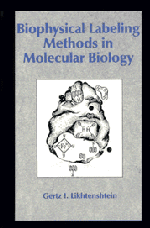Book contents
- Frontmatter
- Contents
- Preface
- Abbreviations
- 1 The method of spin labeling
- 2 Double-labeling techniques
- 3 Fluorescent labeling methods
- 4 Triplet labeling methods
- 5 Mössbauer spectroscopy, electron scattering, and other labeling methods
- 6 Studies of proteins and enzymes: structure, dynamics, and mechanism of action
- 7 Structure and dynamics of membranes
- 8 Nucleic acids and other biological systems: biological assays
- Conclusion
- References
- Index
6 - Studies of proteins and enzymes: structure, dynamics, and mechanism of action
Published online by Cambridge University Press: 29 January 2010
- Frontmatter
- Contents
- Preface
- Abbreviations
- 1 The method of spin labeling
- 2 Double-labeling techniques
- 3 Fluorescent labeling methods
- 4 Triplet labeling methods
- 5 Mössbauer spectroscopy, electron scattering, and other labeling methods
- 6 Studies of proteins and enzymes: structure, dynamics, and mechanism of action
- 7 Structure and dynamics of membranes
- 8 Nucleic acids and other biological systems: biological assays
- Conclusion
- References
- Index
Summary
As follows from Chapters 1–5, problems such as the structures of active centers of enzymes and receptors, localization of specific zones on macromolecules, and mutual disposition of centers of complex protein and membrane systems can be studied by means of spin, fluorescence, triplet, tritium, and electron-scattering labeling. The first three methods are used to determine the parameters of rotational and translational diffusion and to monitor conformational and phase transitions. The intramolecular dynamics of protein globules and the surrounding water shell are monitored by the whole collection of spin, fluorescent, triplet, and Mössbauer labels. Modification of proteins by spin and triplet labels offers the opportunity to characterize the conducting ability of protein globules and to determine the values of steric factors. Nitroxide spin labels can be used to probe the local redox properties of the electron transport system.
In this chapter we shall consider the main results of applying biophysical labeling to proteins and enzymes. Since there has been a great variety of publications in this field, we must limit the examples cited to only the most typical.
Active centers of enzymes
Sterine proteases
Serine proteases are uses as a “proving ground” for various versions of the spin-labeling method. The active centers of these enzymes consist of two portions: (1) the catalytic hydrolase center, with an active serine group, and (2) an additional center providing specific binding to a substrate and precise orientation of the reacting groups of the substrate and the catalyst (so-called aryl- and amide-binding segments).
- Type
- Chapter
- Information
- Biophysical Labeling Methods in Molecular Biology , pp. 158 - 200Publisher: Cambridge University PressPrint publication year: 1993



